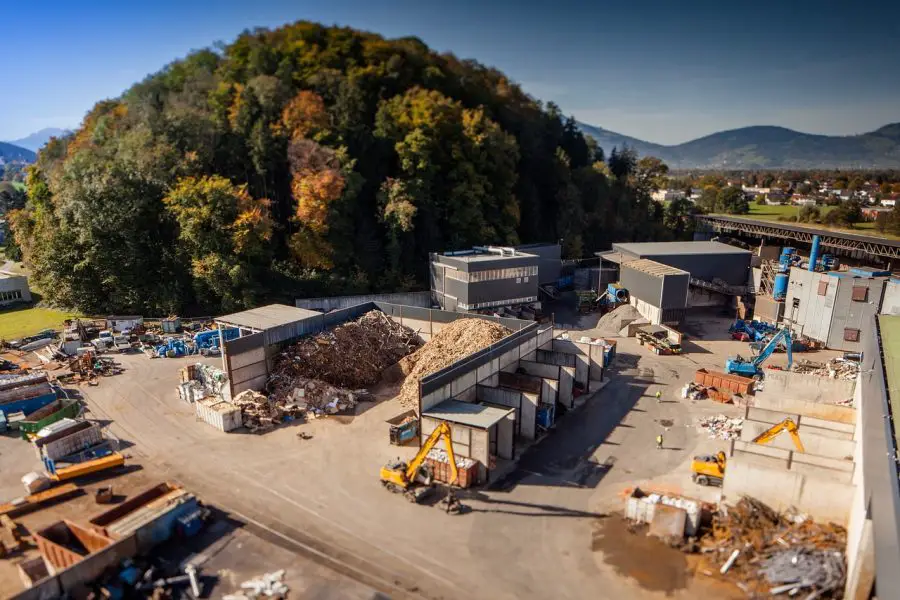
Discover AI’s potential in waste management! Uncover how technology transforms sustainability and boosts efficiency in our latest engaging read.
Ever wondered about AI’s potential in waste management? It’s a topic that’s gaining momentum in our tech-driven world.
As we strive for sustainability, artificial intelligence is stepping up, turning waste management from a mundane task into a sophisticated process.
This blog post dives into the fascinating intersection of AI and waste management, revealing how this technology is revolutionizing the way we handle waste.
So, buckle up and get ready for an enlightening journey into the future of waste management!
Understanding AI’s Potential in Waste Management

Welcome to our deep dive into the world of AI’s potential in waste management.
In this post, we’re going to explore how artificial intelligence is reshaping the landscape of waste management, making it more efficient and sustainable.
We’ll delve into the challenges faced by industrial corporations, the innovative strategies being employed, and the transformative role of AI methodologies like the Analytic Network Process (ANP) and Fuzzy Analytic Network Process (FANP).
Plus, we’ll answer some of the most frequently asked questions about AI in waste management.
So, let’s get started on this exciting exploration of technology’s role in creating a cleaner, greener future!
Importance of Sustainability in Industrial Corporations
Let’s start with the big picture, sustainability. It’s more than just a buzzword; it’s a necessity, especially for industrial corporations.
These entities are major players in our economy, but they also have a significant environmental footprint.
From energy consumption to waste production, their operations can have a profound impact on our planet.
That’s where sustainability comes in. By adopting sustainable practices, industrial corporations can reduce their environmental impact, conserve resources, and contribute to a healthier planet.
But it’s not just about the environment. Sustainability also makes good business sense.
It can lead to cost savings, improved brand reputation, and increased customer loyalty.
So, it’s clear that sustainability is a crucial consideration for industrial corporations.
Challenges in Assessing Sustainability Performance
Now, while the importance of sustainability is clear, assessing sustainability performance is a whole different ball game.
It’s a complex process with many challenges. For one, there’s the issue of quantifying sustainability.
How do you measure something as broad and multifaceted as sustainability?
It involves various aspects, from waste management to energy efficiency, water conservation, and more.
Then, there’s the challenge of data collection. Gathering accurate and comprehensive data for sustainability assessment can be a daunting task.
Plus, there’s the need for standardization. With different corporations using different metrics and standards, comparing sustainability performance can be like comparing apples to oranges.
These challenges make assessing sustainability performance a tricky task, but one that’s crucial for progress in our sustainable journey.
Sustainability Assessment in Industrial Corporations
As we move forward in our exploration of AI’s potential in waste management, let’s turn our attention to the role of sustainability assessment in industrial corporations.
It’s a topic that’s as complex as it is crucial. With the increasing importance of sustainable practices, understanding how to measure and improve sustainability performance has become a key focus for industries worldwide.
In this section, we’ll delve into the current strategies used for sustainability assessment, their limitations, and the need for more integrated approaches.
So, let’s dive in and unravel the intricacies of sustainability assessment in the industrial world!
Current Strategies and Their Limitations
When it comes to assessing sustainability in industrial corporations, several strategies are currently in use.
These may include tracking key performance indicators (KPIs) related to energy use, waste generation, water consumption, and more.
Some corporations might also use sustainability reporting frameworks like the Global Reporting Initiative (GRI) or adhere to international standards like ISO 14001 for environmental management.
However, these strategies come with their own set of limitations.
For instance, KPIs can provide valuable data, but they often focus on specific areas, potentially overlooking other important aspects of sustainability.
Similarly, while reporting frameworks and standards provide a structured approach, they can be complex and time-consuming to implement.
Plus, they may not fully capture the unique sustainability challenges and opportunities of each corporation.
The Need for Integrated Assessment Approaches
Given these limitations, there’s a growing recognition of the need for more integrated assessment approaches.
These approaches aim to provide a more holistic view of sustainability, taking into account the interconnections between different sustainability aspects.
They can help corporations identify not only their sustainability strengths and weaknesses but also the potential trade-offs and synergies between different sustainability goals.
For instance, an integrated approach might involve combining traditional KPI tracking with more innovative tools like life cycle assessment or the use of AI and machine learning for data analysis.
By doing so, corporations can gain a more comprehensive understanding of their sustainability performance and identify more effective strategies for improvement.
In the next section, we’ll delve deeper into one such innovative tool – the Analytic Network Process (ANP) and its fuzzy counterpart, the Fuzzy Analytic Network Process (FANP).
Description of the Analytic Network Process (ANP) and Fuzzy Analytic Network Process (FANP) methods

Explanation of ANP
Let’s start with the Analytic Network Process (ANP). ANP is a decision-making tool that allows us to manage complex decisions by considering all possible scenarios.
It’s like a map that helps us navigate the complex landscape of decision-making.
ANP uses a network structure instead of a hierarchical one, which means it can handle more complex and interdependent relationships.
It’s like a web where each point is connected to every other, allowing for a more comprehensive and nuanced analysis.
Basics of Fuzzy Sets Theory
Next up is the fuzzy sets theory. Don’t let the name fool you, there’s nothing ‘fuzzy’ about its importance.
The fuzzy sets theory is a mathematical approach to dealing with uncertainty and imprecision.
Unlike traditional sets that have clear boundaries (an element either belongs to the set or it doesn’t), fuzzy sets allow elements to have degrees of membership.
This makes it a powerful tool for handling real-world problems where boundaries can often be, well, fuzzy.
Explanation of FANP
Now, what happens when you combine the ANP with the fuzzy sets theory?
You get the Fuzzy Analytic Network Process (FANP). FANP takes the best of both worlds, the comprehensive decision-making framework of ANP, and the ability to handle uncertainty from the fuzzy sets theory.
This makes FANP a powerful tool for assessing sustainability performance, where decisions are complex and data can be uncertain.
LFPPM Algorithm
Last but not least, let’s talk about the LFPPM algorithm.
LFPPM stands for ‘Learning From Past Project Mistakes’, and it’s an algorithm designed to help organizations learn from their past experiences.
By analyzing past projects, the LFPPM algorithm can identify patterns and trends, helping organizations avoid repeating the same mistakes and continually improve their performance.
In the context of sustainability assessment, the LFPPM algorithm can provide valuable insights to help industrial corporations enhance their sustainability strategies.
Application of FANP in Sustainability Performance Assessment
Now that we’ve got a handle on the concepts of ANP, fuzzy sets theory, FANP, and the LFPPM algorithm, let’s see them in action!
In this section, we’re going to explore how these tools are applied in the real world of sustainability performance assessment.
We’ll look at how they’re currently being used, and why there’s a growing need for their application in industrial corporations.
So, if you’re ready to see theory turn into practice, let’s dive into the fascinating world of FANP applications in sustainability performance assessment!
Current Applications of FANP
FANP is already making waves in various fields. Its ability to handle complex, interdependent decisions and deal with uncertainty makes it a valuable tool in many contexts.
For instance, in the realm of sustainability performance assessment, FANP is used to evaluate and rank different sustainability indicators, providing a more nuanced understanding of a corporation’s sustainability performance.
FANP is also used in strategic planning and decision-making, where it helps organizations navigate complex decisions and trade-offs.
For example, it can be used to evaluate different investment options, taking into account various factors like financial returns, risks, and sustainability impacts.
The Need for New Applications in Industrial Corporations
While FANP has proven its worth in these applications, there’s a growing need for its use in industrial corporations.
These corporations face complex sustainability challenges that require sophisticated tools like FANP.
For instance, they need to balance economic performance with environmental and social impacts, manage complex supply chains, and navigate changing regulatory landscapes.
Moreover, as sustainability becomes a strategic priority, industrial corporations need tools that can integrate sustainability considerations into their core decision-making processes.
FANP, with its ability to handle complex, interdependent decisions and deal with uncertainty, is well-suited to meet this need.
By adopting FANP and similar tools, industrial corporations can enhance their sustainability performance assessment, make more informed decisions, and ultimately, contribute to a more sustainable future.
AI’s Potential in Waste Management FAQs

As we journey through the intriguing world of AI’s potential in waste management, you might have a few questions popping up.
Well, you’re in luck! This section is all about addressing those burning questions.
We’ve gathered some of the most frequently asked questions about AI in waste management and will provide clear, concise answers to each.
From the role of AI in sanitation to its benefits for the environment, we’ve got you covered. So, let’s dive into the FAQs and quench your curiosity!
Q: How are AI and robots changing waste management?
A: AI and robots are revolutionizing waste management in several ways.
They’re being used to automate the sorting process at waste facilities, which increases efficiency and reduces the need for manual labor.
Robots, guided by AI, can sort waste more accurately and quickly than humans, leading to more effective recycling and less waste going to landfill.
Q: How is smart waste management using AI?
A: Smart waste management uses AI to optimize waste collection and processing.
For instance, AI can analyze data from smart bins to determine when they’re full and need to be emptied, leading to more efficient collection routes.
AI can also be used in waste processing facilities to automate sorting and identify valuable recyclable materials.
Q: How does AI help clean water and sanitation?
A: AI can help clean water and improve sanitation by predicting and identifying pollution sources, optimizing treatment processes, and monitoring water quality in real time.
For example, AI algorithms can analyze data from various sensors to detect contaminants in water, enabling quicker responses to pollution incidents.
Q: What is the role of AI in sanitation?
A: AI plays a significant role in improving sanitation systems.
It can be used to optimize the operation of wastewater treatment plants, predict sanitation needs in urban areas, and even automate the cleaning and maintenance of public restrooms.
AI can also help in planning and implementing sanitation infrastructure in developing regions.
Q: How is AI used to solve environmental problems?
A: AI is used to solve environmental problems in many ways.
It can help monitor and protect biodiversity, predict and mitigate the effects of climate change, optimize energy use, and promote sustainable agriculture, among other things.
In the context of waste management, AI can improve recycling rates and reduce the amount of waste going to landfill.
Q: What are the benefits of AI for the environment?
A: AI offers numerous benefits for the environment.
It can help us understand and mitigate the impacts of climate change, protect biodiversity, and promote sustainable practices.
In waste management, AI can increase recycling rates, reduce the amount of waste going to landfill, and even help us find new uses for waste materials.
By helping us manage our resources more efficiently and sustainably, AI can play a crucial role in protecting our planet.
AI’s Potential in Waste Management Conclusion

As we reach the end of our exploration of AI’s potential in waste management, it’s time to wrap up and reflect on what we’ve learned.
In this concluding section, we’ll summarize the key points from our journey and look ahead to the future of AI in waste management.
From the challenges faced by industrial corporations to the innovative solutions offered by AI, we’ve covered a lot of ground.
So, let’s take a moment to bring it all together and envision what the future might hold for AI in waste management. Ready? Let’s dive in!
Summary of the Potential of AI in Waste Management
Reflecting on our exploration, it’s clear that AI holds immense potential in the realm of waste management.
From automating waste sorting to optimizing collection routes, AI is transforming the way we manage waste.
It’s helping us increase efficiency, reduce costs, and improve the sustainability of waste management practices.
Moreover, AI’s ability to handle complex decisions and deal with uncertainty makes it a powerful tool for assessing sustainability performance.
By providing a more nuanced understanding of sustainability, AI can help industrial corporations make more informed decisions and enhance their sustainability strategies.
Future Directions for Research and Application
Looking ahead, the future of AI in waste management is ripe with possibilities.
As technology continues to advance, we can expect to see even more innovative applications of AI.
For instance, we might see AI being used to predict waste generation patterns, enabling us to better plan waste management strategies.
We might also see more sophisticated AI algorithms that can identify and sort waste materials with even greater accuracy.
In terms of research, there’s a need for more studies exploring the practical applications of AI in waste management.
We also need more research on how to integrate AI tools into existing waste management systems and how to overcome the barriers to AI adoption.
In conclusion, while we’ve made significant strides in harnessing AI’s potential in waste management, there’s still much to explore and learn.
As we continue to innovate and push the boundaries of what’s possible, there’s no doubt that AI will play a pivotal role in shaping the future of waste management.






